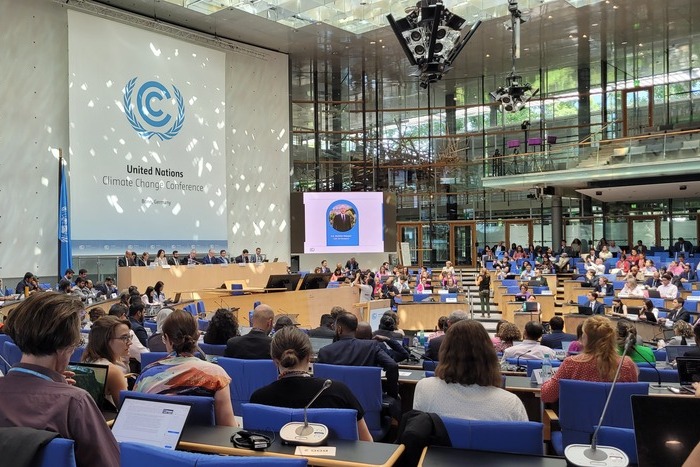Developing countries demand financial clarity and commitment at the Bonn Climate Change Conference 2025
At the ongoing SB62 session in Bonn, a Consultation with the Parties was held on the Baku to Belém (B2B) Roadmap – a joint initiative by the COP29 and COP30 Presidencies to scale climate finance to at least $1.3 trillion annually by 2035. According to the COP29 President, this marks the most significant finance target ever put forward under the UN process. The consultation brought Parties together to unpack how this target can move from political commitment to real-world action.
Setting the Stage
COP29 President Mukhtar Babayev called the Baku outcome “historic” and stressed that while the agreement did not satisfy everyone, the process must now shift toward implementation. He raised concern over limited engagement from Multilateral Development Banks (MDBs), with only two submissions received, and emphasized the need for grants and concessional finance to be the backbone of climate finance.
The COP30 Presidency underlined that all actors – governments, MDBs, private sector, and civil society – must contribute to ensure developing countries can access the finance needed for climate action. They reiterated that the roadmap is not a negotiated outcome but a process guided by decisions from CMA 6 and to be finalised at CMA 7, the formal sessions under the Paris Agreement focused on implementation of key elements like NDCs, the Global Stocktake, and Climate Finance, etc.
UNFCCC Executive Secretary Simon Stiell said, “Climate finance is not a favour. It is not charity. It is an investment in global stability.” He called for grant-based, non-debt instruments, easier access to funds, and better leveraging of private finance, especially through enabling environments and reform of existing finance channels.
Principles Guiding the Roadmap
The consultation reaffirmed three core principles shaping the structure and content of the roadmap:
- Solutions-Oriented – The roadmap should be built on real, scalable actions that address systemic barriers and deliver results.
- Engaging a Wide Array of Actors – Public and private institutions, financial actors, and other stakeholders must play active roles.
- Country Ownership – Finance flows must align with national priorities and respect the contexts of developing countries.
The roadmap is expected to reflect these principles through a variety of tools and content, including case studies, innovative instruments, fund structures, enabling actions, and cooperative efforts – all anchored in existing multilateral initiatives.
What Different Groups Said
The G77+China group said that the roadmap must remain within the mandate of CMA 6 and CMA 7, and guided by the principles of equity and Common But Differentiated Responsibilities and Respective Capabilities (CBDR-RC). This has been a principle that G77+China has consistently pushed for in order to ensure that historical responsibility is not diluted .They stressed upon transparency, evolving needs of developing countries, and keeping its long-standing demand of adaptation and just transition finance at the centre.
The Alliance of Small Island States (AOSIS), representing some of the most climate-vulnerable nations, called for direct access modalities, instruments like debt-for-climate swaps, and better use of multilateral funds for small island and vulnerable nations.
Least Developed Countries (LDCs) demanded clarity on roles, increased access to adaptation and loss and damage finance, and tripling adaptation finance by 2030. They asked for clear tracking mechanisms and action points in the roadmap. Previous climate finance pledges, such as the $100 billion goal, did not have clear timelines and lacked accountability frameworks, which resulted in delivery shortfalls, leaving climate vulnerable countries without the promised support.
The Arab Group called for geographic balance – highlighting disparities in regional finance flows and stressed that adaptation remains underfunded. They strongly pushed back on the over-reliance on debt and urged developed countries to meet their finance obligations in grant-equivalent terms—a demand that it has been consistently making at previous COPs.
India on Behalf of LMDCs
India delivered a strategic intervention on behalf of the Like-Minded Developing Countries (LMDCs), aligning with G77 and the Arab Group. It reiterated that the Roadmap process is a joint Presidency-led exercise – not a negotiation and must ensure clarity, transparency, and inclusiveness in both process and substance. This intervention highlights the importance of transparency in such processes.
LMDCs underscored that the roadmap must:
- Have Article 9.1—under which developed countries are obligated to provide climate finance—as the central pillar.
- Focus on non-debt instruments and enhanced access for developing countries.
- Avoid shifting responsibilities to developing countries or relying on market-based finance that is unaffordable.
- Reflect the needs and priorities of developing countries, rather than a one-size-fits-all model.
They also called for more clarity on the Roadmap’s format, clearer timelines, and requested further consultations before COP30 to improve inclusivity and ownership.
What’s Next?
While the format and actions under the Roadmap are still being developed, the discussion at SB62 set a clear tone: ambition must be matched by action, and process must be grounded in equity, public leadership, and accessibility. While the agenda of SB62 was gavelled after much deliberation, Article 9.1 was not accepted—highlighting the glaring gap that continues to persist between developed and developing countries on the core issue of finance obligations. Consultation with non-party stakeholders is yet to take place.
About The Author
You may also like
Companies in BASIC nations are turning carbon rules into an advantage: Report
Can green trade barriers save the environment?
Brazil Set 60-Day Deadline for Fossil Fuel Phase Out Plan
Litigation increases legalisation of protection against climate threats: Report
What COP30 reveals about the next phase of multilateralism

